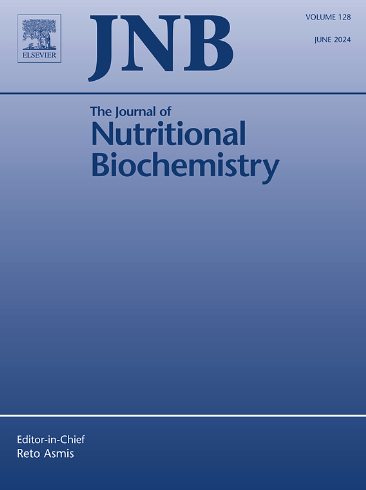Joint effect of hyperuricemia and severe vitamin D deficiency on all-cause and cardiovascular mortality among individuals with diabetes
IF 4.9
2区 医学
Q1 BIOCHEMISTRY & MOLECULAR BIOLOGY
引用次数: 0
Abstract
This study aims to investigate the individual and joint associations of hyperuricemia (HUA) and severe Vitamin D deficiency (SVDD) on the all-cause and cardiovascular disease (CVD) mortality among patients with diabetes mellitus (DM) by analyzing data from the National Health and Nutrition Examination Survey (NHANES). Data of DM patients aged ≥20 years from the NHANES 2001-2018 were included in this study. Survey-weighted multivariable cox proportional hazards regression models, Kaplan–meier curve and restricted cubic spline analysis were employed to evaluate the individual and joint associations of HUA and SVDD with the all-cause and CVD mortality of DM patients. Sensitivity analyses, propensity score matching, and stratified analyses were performed to test the stability of our findings. Mediation analysis based on SIRI and HbA1c was also conducted. A total of 7,869 (Weighted N=27512325) patients with DM aged 20 and older were involved. The weighted mean (standard deviation (SD)) level of SUA and 25-hydroxyvitamin D (25(OH)D) were 5.74 (1.58) mg/dL and 62.51 (27.80) nmol/L, respectively. The mean follow-up time was 6.83±4.63 years, and 1,967 deaths were documented. The all-cause and CVD mortality rates per 1,000 person-year among DM patients were 28.30 and 9.49, respectively. After adjusting for confounding factors, patients with HUA and SVDD exhibited the higher risk of all-cause [HR: 1.28 (1.09–1.50) for HUA and 1.44 (1.07–1.94) for SVDD] and CVD [HR: 11.54 (1.01–2.36) for HUA and 1.98 (1.19–3.28) for SVDD] mortality. Kaplan–Meier curves demonstrated a statistically significant difference in survival probability over different HUA and SVDD categories among DM patients. The joint analysis revealed that HUA and SVDD have a joint effect on all-cause mortality (HR: 1.90 [1.23–2.93]) and CVD mortality (HR: 2.60 [1.45–4.65]) among patients with DM. Sensitivity analysis, propensity score matching and stratified analyses confirmed the stability of the research results. Mediation analyses further revealed that 11.4% of the SUA–mortality association was mediated through SIRI, and 1.96% of the 25(OH)D–mortality association through glycated hemoglobinA1c (HbA1c). HUA and SVDD comorbidity is significantly associated with elevated risk of all-cause and CVD mortality in DM patients. These findings indicate that concurrent management of HUA and SVDD may improve prognosis of DM patients.
高尿酸血症和严重维生素D缺乏对糖尿病患者全因死亡率和心血管死亡率的共同影响
背景:本研究旨在通过分析全国健康与营养调查(NHANES)的数据,探讨高尿酸血症(HUA)和严重维生素D缺乏症(SVDD)与糖尿病(DM)患者全因和心血管疾病(CVD)死亡率的个体和联合关系。方法:纳入2001-2018年NHANES中年龄≥20岁的DM患者的数据。采用调查加权多变量cox比例风险回归模型、Kaplan-meier曲线和限制性三次样条分析评估HUA和SVDD与DM患者全因死亡率和CVD死亡率的个体和联合关系。进行敏感性分析、倾向评分匹配和分层分析来检验我们研究结果的稳定性。基于SIRI和HbA1c的中介分析。结果:共7869例20岁及以上DM患者(加权N = 27512325)。SUA和25-羟基维生素D (25(OH)D)的加权平均值(标准差(SD))分别为5.74 (1.58)mg/dL和62.51 (27.80)nmol/L。平均随访时间为6.83±4.63年,记录死亡1967例。糖尿病患者的全因死亡率和心血管疾病死亡率分别为28.30和9.49 / 1000人。在调整混杂因素后,HUA和SVDD患者的全因死亡率[HR: 1.28 (1.09-1.50), SVDD为1.44(1.07-1.94)]和CVD [HR: 11.54 (1.01-2.36), SVDD为1.98(1.19-3.28)]的死亡率更高。Kaplan-Meier曲线显示不同HUA和SVDD类型DM患者的生存概率有统计学差异。联合分析发现,HUA和SVDD对糖尿病患者全因死亡率[HR: 1.90(1.23-2.93)]和CVD死亡率[HR: 2.60(1.45-4.65)]有共同影响。敏感性分析、倾向评分匹配和分层分析证实了研究结果的稳定性。调解分析进一步显示,11.4%的sua -死亡率关联是通过SIRI介导的,1.96%的25(OH) d -死亡率关联是通过糖化血红蛋白a1c (HbA1c)介导的。结论:HUA和SVDD合并症与糖尿病患者全因和CVD死亡风险升高显著相关。这些发现提示HUA和SVDD同时治疗可能改善DM患者的预后。
本文章由计算机程序翻译,如有差异,请以英文原文为准。
求助全文
约1分钟内获得全文
求助全文
来源期刊

Journal of Nutritional Biochemistry
医学-生化与分子生物学
CiteScore
9.50
自引率
3.60%
发文量
237
审稿时长
68 days
期刊介绍:
Devoted to advancements in nutritional sciences, The Journal of Nutritional Biochemistry presents experimental nutrition research as it relates to: biochemistry, molecular biology, toxicology, or physiology.
Rigorous reviews by an international editorial board of distinguished scientists ensure publication of the most current and key research being conducted in nutrition at the cellular, animal and human level. In addition to its monthly features of critical reviews and research articles, The Journal of Nutritional Biochemistry also periodically publishes emerging issues, experimental methods, and other types of articles.
 求助内容:
求助内容: 应助结果提醒方式:
应助结果提醒方式:


